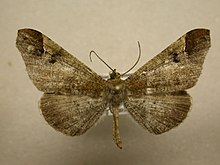Hedylidae
| Hedylidae | |
|---|---|

| |
| Macrosoma bahiata | |
| Scientific classification | |
| Domain: | Eukaryota |
| Kingdom: | Animalia |
| Phylum: | Arthropoda |
| Class: | Insecta |
| Order: | Lepidoptera |
| Clade: | Obtectomera |
| Superfamily: | Papilionoidea Scoble, 1986 |
| Family: | Hedylidae Guenée, 1857, nec. Bergh, 1895 |
| Genus: | Macrosoma Hübner, 1818 |
| Type species | |
| Macrosoma tipulata Hübner, 1818 | |
| Species | |
|
see List of species | |
| Diversity | |
| 35 currently recognised species | |
| Synonyms | |
| |
Hedylidae is a family of insects in the lepidopteran order, They are also called the "American moth-butterflies". Butterflies evolved from moths, and this group is rather moth-like.
They are living sister group to the butterfly superfamily Papilionoidea. In 1986, Scoble combined all 35 species into a single genus Macrosoma. They are all entirely neotropical species from central and southern America and the Caribbean.[1]
DNA sequence analysis of this group continues.
References[change | change source]
- ↑ Scoble MJ (1986). "The structure and affinities of the Hedyloidea: a new concept of the butterflies". Bull. Brit. Mus. (Nat. Hist.) (Ent.). 53: 251–286.
